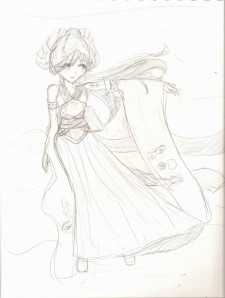Now following up on my post about how to tell real Geisha and Maiko from tourists that happen to be dressed up I want to talk about the different types of kimono and how the kimono came to be. I am in no way an expert on this matter, this is just information I’ve gathered from different sources. If I get something wrong, please let me know and I’ll fix it right away.
First a little history lesson. Some may know that Japan was originally a part of China until they won their independence from them hundreds and hundreds of years ago. When this gain of independence happened Japan was determined to create their own culture, including the clothing. Clothes from China were tailor made, this process made it expensive to get clothing for families and difficult to mass produce, also nearly impossible to pass down through the generations. So some witty women made a way to create clothing that can last a longer time and be passed down from person to person, this was the method of square sewing, you see, if you look at a kimono, you will see that basically every part of the fabric is a square (or rectangle for you literal people) they could wrap the clothing around themselves and tie a sash (That eventually evolved to an Obi) around themselves to hold the kimono in place so there was a lot of room for different body types. Though Kimono were initially worn by peasants, and as the undergarments of dignitaries they have become the national clothing and the national symbol of Japan. Women, though underestimated in the culture actually played a huge part in the culture, including in the writing, women weren’t allowed to be educated enough to recognize many of the complicated characters that were brought over from China, so what did they do? They created a completely new writing system now known as Hirigana and Katakana. The first kimonos were very basic, but along with the culture they evolved to be quite refined. Much of the process of putting on a kimono these days isn’t even seen, what with all of the wrapping, undergarments, and pillows used to keep everything straight and to keep the column like shape that kimono are known for.
Now that the history lesson is over, we can look at some different types of kimono
First I want to cover the underkimono, the ones that you don’t really see, or that you see only the edge of but are still necessary in proper kimono.
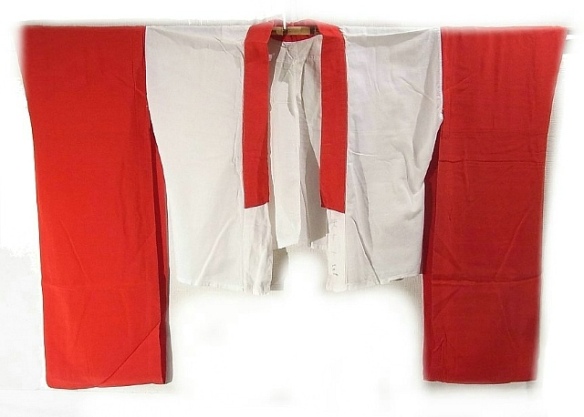
The sleeves length of the Han-Juban depends on the length of the kimono that will be worn over it.
The bottom most kimono is called a han-juban. It’s basically the kimono version of underwear. The material is very light and unlined and is only about as long as a shirt. It’s main function is to keep the expensive silk away from the wearers skin, seeing as how skin can get oily and sweaty and the silk is quite difficult to clean. A woman will also wear a sort of wrap around her waist that will act as skirt of sorts, called a sasoyke.

The second underkimono is called a Juban. You’ll see a bit of the juban at the very edge of the outer kimono sleeves and colar and on the inner part of back part of the collar that comes off a girls neck. You’ll also see the juban when a girl lifts up her kimono, the most likely place you would see this is with Geisha and Maiko when they lift up their kimono to walk through the streets. The juban is much shorter than a normal kimono and doesn’t require the tucking that a normal kimono would need. Though many people who buy kimono would think that this is a full kimono, that’s not the case. The Juban can be made out of just about any material, though because it’s going to be under the main kimono, a lighter silk or linen is preferred to make sure that everything isn’t too hot. They may or may not be lined, depending on how formal you want to be.

The Yukata is one of the least formal kimono. They are basically summer kimono meant to be worn during festivals or even just going out. Because they are meant to be worn during the warmer weather they are unlined and are normally made of linen or cotton, so they can easily breath. They are also often used by spas, hot springs, or bath houses for the guests to wear. Normally every household has a few yukata because they are the cheapest, unlike other kimono which are normally rented.
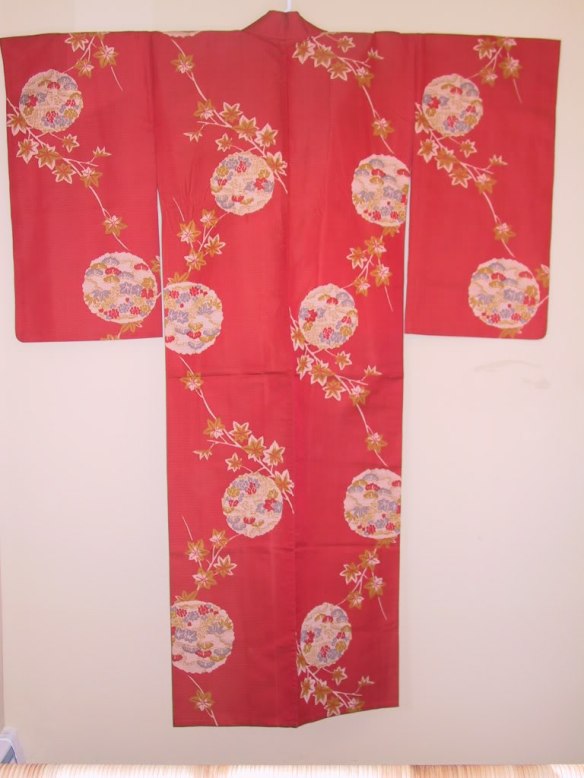
A Komon Kimono is the next in line for formality. They are slightly more formal than Yukata and are meant to be worn every day. They are known by having an all over pattern and are lined. They have the shortest variety of sleeve, along with Yukata and a few more kimono.
Of course the length of the sleeve doesn’t have much to do with the formality, it just depends on the type of kimono.
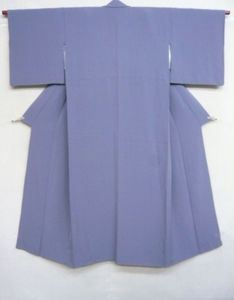
The first adult kimono a person will wear are called Iro Muji and Kuro Muji. The difference between the two being the color and the formality. The lesser formal of the two is the Iro Muji, this is the one that has any color other than black (The black on is called the Kuro Muji). They can be won at both formal and casual events. When crests are added (called mon) the term tomesode will be added at the back of the names, as in iro muji tomesode. Mon are added at the bottom of the back of the collar, the back shoulders and the front shoulders and can be in numbers like 1, 3, and 5. The more mon, the more formal the kimono is. The kuro muji is often worn as mourning garb. The amount of black signifies what stage of mourning a person is at, as in, at the beginning stage, the entire outfit is black, including the obi, hakama, whatever accessories, slowly color will be added as the person goes through those stages of mourning.
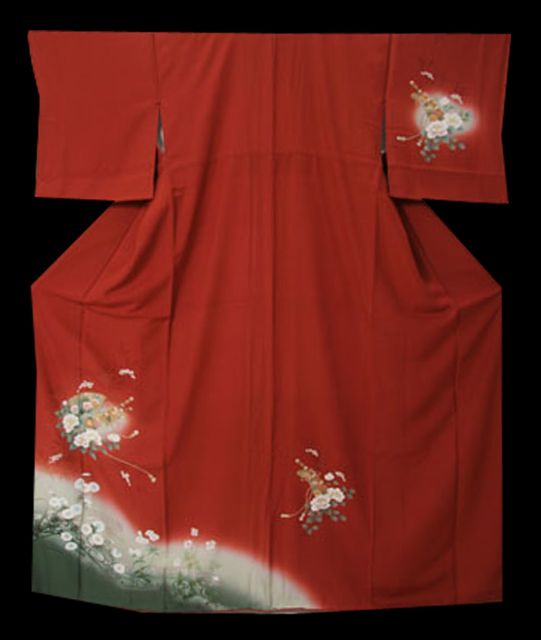
The Tsukesage is slightly more formal than the Iro and Kuro muji. I couldn’t really find a place where they would be worn though sadly, I would guess at some social events. They can be any color and are discernible with a continuous pattern going around the bottom and the middle of the front of the kimono and a small design on the back of one sleeve and the front of another.
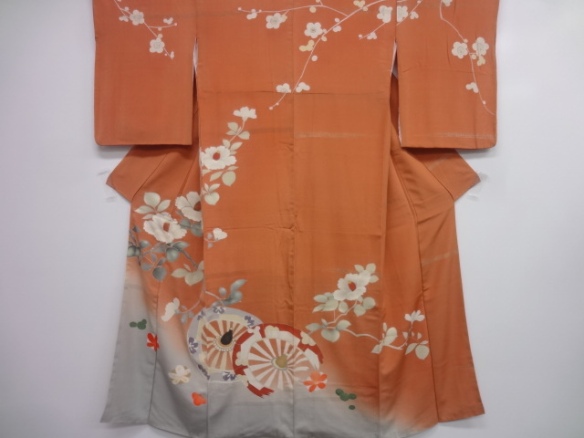
The Houmongi is the next kimono in line of formality. It’s known for the fact that the pattern joins up over the seams. There’s a small pattern that is also commonly on the front and back shoulders. The pattern also goes up over the front as well as the back and is also on the sleeves. This outfit is used for visiting others and going to parties. It’s one of the more formal kimono and should be worn with formal accessories, a brocade for the obi is usually worn with it.
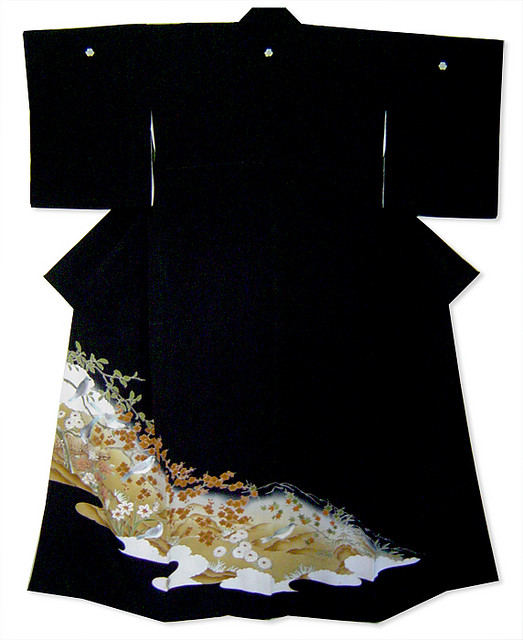
A Tomesode is much like a Houmongi accept that it is normally black or a very very dark color (I say normally because it is possible to have a tomesode with color These are called Iro Tomesode or Irosode) painted on the tomesode is a very complex design at the hem that connects through the seems, this design will go to about as high as the knee. This Kimono is worn by married women at formal occasions such as weddings. Like the Kuro Muji and Iro Muji, Mon (crests) are used on the kimono, again, the more crests, the more formal the kimono is.

A group of girls wearing Furisode and winter accessories.
The only reason why I have the Furisode as more formal than the Tomesode is because they are more ornate, though they aren’t any more formal than Tomesode. Furisode are worn by young women before they get married. The Furisode is known for the long length of their sleeves, there are three lengths of Furisode sleeve, the longer the sleeve he more formal, the longest is almost floor length, so it’s not uncommon to see girls walking around with the sleeves wrapped around their arm to save them from getting dirtied by the ground. The occasions a young woman would wear this type of kimono are their graduation (usually worn with a Hakama which is a type of very baggy pant, you might see pictures of samurai or martial artists wearing them), a wedding, or coming of age day (A special day that celebrates 20 year olds, which is when a person is considered an adult in Japan) they may also just rent them out when they go through touristy areas like Kyoto. The color and design of the pattern varies but makes no difference in terms of the formality of the kimono.
Special occasion Kimono
This section is to highlight kimono that wouldn’t normally be worn by normal people of Japan, meaning they are worn by dancers, geisha, maiko, and Brides on their wedding day. If you see someone wearing these kimono it’s certainly a special occasion and a rare sight. The way I have these listed has no meaning, they’re not more important or rare-er they’re just listed off.

Odori Katamigawari, that’s a mouthful. These kimono are worn by dancers and performers and are known for being half one (or more) color and half another color (or design if one so chooses). These kimono are made of synthetic material so they can be more easily washed and are unlined to keep the performers cooler. Keep in mind the Odori Katamigawari is not the only kimono used in performances, basically any type of kimono can be used in dances, they just stick the word Odori in front of it (Odori translates to Dance) for example, if a tomesode were used in a dance (again unlined and made of synthetic material) it would be called an Odori Tomesode. You would not normally see a person wearing these kimono unless they were in a dance or were acting out a performance.

A Shirokakeshita is the traditional kimono a bride would wear during a shinto wedding. Think of this wedding kimono as the wedding dress we wear during western weddings, the white is to signify pureness, but it goes a bit deeper than that, because it also signifies the brides willingness to be colored by the family she is marrying in to(As in the customs, values, and traditions). This kimono also has sleeves like that on a furisode and can have padding around the hem, the reason they do this is so, as the bride is walking, it drags on the ground in an appealing way, again comparing it to western weddings, think of the veil and the train of the dress. Though this kimono is important the Bride can go through as many as 5 costume changes during her wedding, though in modern times many opt to just go through 2 or 3 costume changes, ending with a black tomesode (remember, they’re for married women).

A bride in full wedding garb, including the uchikake
The Uchikake is another kimono a girl will wear during her wedding, like the Shirokakeshita it has a padded hem and Furisode sleeves. Unlike the Shirokakeshita it has a colorful design, unless the wedding is a shinto wedding in which, again, it will be white. It’s worn more like a coat, over the Shirokakeshita or the Kakeshita (covered next) and does not have an obi tied around it. The hem will be held up by the bridesmaids while the bride is walking down the isle.
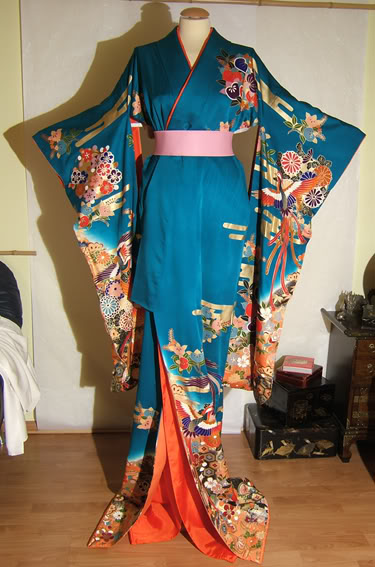
A kakeshita with a simple tie (not a proper obi)
The final wedding kimono is called the Kakeshita. This kimono is worn in place of the shirokakeshita and instead of it being white, it’s very colorful, again with a padded hem and the furisode sleeves. Though it’s not as popular to wear as the Shirokakeshita brides can opt to change into this if they wish.

Two Maiko wearing Hikizuri, you can see the tucks in the sleeves and in the shoulders. You can also see how they drag on the ground as the girls dance.
The Hikizuri is the kimono that Geisha and Maiko wear. For a Maiko the sleeves are long with a tuck in the sleeves and a tuck in the shoulders to mimic what parents do to children’s kimono. As for the Geisha, the sleeves are cut short, to the same kind as a tomesode and the patterns and design are more mature. The hikizuri is almost like a kakeshita wedding kimono in the sense that it’s made to be dragged on the ground with the padded hem. The Maiko and Geisha use their kimono in their dance, moving in them gracefully and lifting them up revealing the Juban while walking through the streets from appointment to appointment. This is made all the more difficult with the traditional high okobo shoes they wear.
I hope this helps, as you can see this mainly concentrates on kimono women wear, that’s because women have the most variety in kimono. If I got anything wrong please let me know, this took quite a while to write but hopefully it will help people in recognizing the types of kimono.
I may make another on the different types of accessories, but I’m not promising anything. XD















































 (This is one of her pictures from her debut, she was so cute and giggly, this was the only picture where she didn’t have a laugh going on)
(This is one of her pictures from her debut, she was so cute and giggly, this was the only picture where she didn’t have a laugh going on)

























